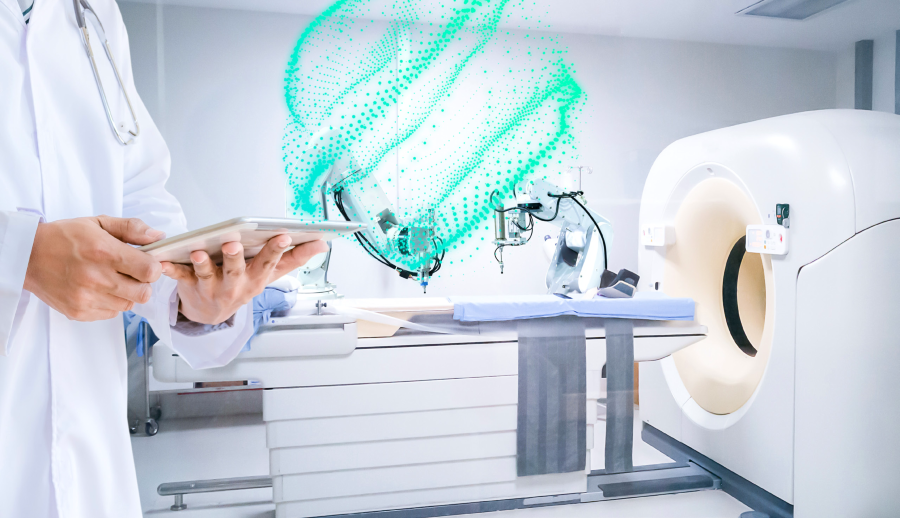Medical device manufacturing response to COVID-19

The world’s poor response to the COVID-19 pandemic highlighted needed changes in medical device manufacturing.
On January 30, 2020, the World Health Organization (WHO) issued a public health emergency of international concern (PHEIC), officially warning the world of an imminent global threat. As COVID-19 continued its malicious spread across both hemispheres, the warning and preventative guidelines went mostly unheeded. On March 11, 2020, the WHO declared that COVID-19 was indeed a pandemic and that government officials, already overburdened with the rise in coronavirus cases, needed to take immediate action. One of those actions included expanding the production of ventilators and personal protection equipment (PPE) used in the COVID-19 fight.
The damage had already been done.
Medical device manufacturers were left scrambling
Having sufficient medical supplies like ventilators and personal protective equipment (PPE) was omitted in the original PHEIC recommendations, only becoming a consideration later. The world quickly realized its error; during the early months after COVID-19 was declared a pandemic, there were not nearly enough ventilators to handle the overwhelming number of individuals requiring respiration assistance. Pre-pandemic estimates counted 62,000 full-featured ventilators plus 98,000 partially equipped ventilators, approximately 160,000 in total.[I]
At the same time, shortages of personal protective equipment (PPE) due to misinformation, stockpiling and a halted supply chain had put healthcare workers in danger. For example, one survey by the American Nurses Association discovered that nurses were re-using single-use PPE, albeit knowing decontamination was ineffective.[i]
“The problem [with medical device manufacturing] wasn’t our ability to create the needed medical devices and diagnostic products. It was our inability to react quickly to rapid market demand changes and supply chain disruptions.”[ii]
How medical device manufacturing ventilator production was handled in 2020
To maximize production and help level the disparity, the manufacture of ventilators and ventilator components, for example, was entrusted to outside industries, mostly automotive.
With the assistance of Stop the Spread,
- General Motors (GM) partnered with Ventec Life Systems and completed a contract for 30,000 ventilators.[i]
- Ford partnered with GE Healthcare to make a total of 50,000 ventilators.[ii]
- Honda partnered with Dynaflo Pumps to boost production of the compressors used in ventilators from 300 per month to 10,000 per month.[iii]
From the outside, this seems efficient. It wasn’t. Before a newly ramped-up production could begin contracts and funding had to be gained, collaboration needed to happen, components had to be sourced and plants refurbished. GM and Ford couldn’t fulfill their contracts until late August, seven months after the world was warned about the COVID-19 health emergency and five months after COVID-19 was officially declared a pandemic.
A self-sufficient future requires change
Regardless of current global happenings, when the product being manufactured is meant to save lives, five months is too long. To truly be effective during a global emergency, partners should not need to be found, unrelated industries should not expect emergency funds, and unassociated industrial plants should not be refurbished. Medical device manufacturers should have the flexibility and adaptability to act quickly, efficiently and autonomously. A digital transformation is the means to achieve these goals.
Typically, due to the distinctiveness of this industry, new complex innovations can undergo years of design iterations, rigorous testing, and measured approvals. Design and testing, as well as production on the shop floor, can benefit from utilizing digital twins in a product’s lifecycle. A digital twin acts as a digital replica of the product. It is a means of understanding how the product will operate in a real-world environment like the human body: under pressure, repetitive friction, and/ or contact with bodily fluids. The effectiveness of using simulation for testing and production has yielded a positive return on investments for the manufacturer by removing inaccuracies made during the design stage, thereby reducing waste.
As for testing and approvals, regulatory bodies like the FDA are coming around to the ideas of simulation-based product development and virtual prototyping to drive experimental research and clinical trials. Only through working collaboratively with government entities like the FDA and CDC and emphasizing the benefits of a contemporary approval process.
FDA regulations require that every product has a device history record (DHR). Dilatory manual entry of every DHR has proved to be faulty, often with missing or wrong information. One medical device manufacturer spent approximately 34,500 hours dealing with the inefficiencies of manually entering records; 12,000 of those hours were spent investigating inaccuracies. Capturing data in this way is tedious, counterproductive and expensive, and it provides no real value. However, a digital solution that automatically includes an error-free digital DHR with each product to expedite the manufacturing process is an invaluable asset.
Addressing the above issues along with many others faced in the everyday manufacture of medical devices requires a comprehensive, integrated and unique digital solution that embraces sustainable, cost-effective methods using closed-loop manufacturing processes. It demands a solution geared specifically for the progressively difficult industry which is medical device manufacturing. Opcenter Execution Medical Device and Diagnostic software is an important component within the Siemens Xcelerator portfolio, an all-inclusive package that includes software, hardware and services.
What “ifs”
During the first six months of the pandemic, March through September 2020, the United States experienced 200,000 COVID-19 deaths.[i] Had guidelines been followed and reaction times been instantaneous, how many lives would have been saved. Unfortunately, this is a question that cannot be answered.
Medical device manufacturers can be better prepared for the next global threat, and in the meantime, take advantage of the many benefits specific to medical device manufacturing digital transformation would provide.
About the author
Trisha Garrett is a contract Technical Marketing Writer for Siemens Software Industries. Trisha has experience writing multiple forms of content but now specializes in writing engaging landing pages, emails, social pages and the occasional blog post about B2B manufacturing software solutions.
Trisha has a BFA in history and anthropology from Miami University (Ohio), an MS in library sciences from Drexel University, and a certificate in editing from the University of Chicago.
Trisha lives in Cincinnati, Ohio with her husband of 22 years, one teenage daughter, one teenage son, three dogs and one cat.
[i] Croll L (MD). We’ve hit 200,000 COVID-19 deaths in 6 months. What will the next 6 months look like? Published September 22, 2020. Accessed September 23, 2022. https://abcnews.go.com/Health/hit-200000-covid-19-deaths-months-months/story?id=73055381
[i] Korosec K. GM, Ford wrap up ventilator production and shift back to auto business. TechCrunch. September 1, 2020. https://techcrunch.com/2020/09/01/gm-ford-wrap-up-ventilator-production-and-shift-back-to-auto-business/
[ii] Korosec K. GM, Ford wrap up ventilator production and shift back to auto business. TechCrunch. September 1, 2020. https://techcrunch.com/2020/09/01/gm-ford-wrap-up-ventilator-production-and-shift-back-to-auto-business/
[iii] Stop the Spread. Accelerating America’s ventilator production. Defunct at the end of 2022. Accessed September 20, 2022. https://www.stopthespread.org/ventilators
[i] McClendon S & Proctor K. New Survey Findings from 21 US Nurses: PPE Shortages Persist, Re-Use Practices on the Rise Amid COVID-19 Pandemic. ANA American Nurses Association. Published September 1, 2020. Accessed September 20, 2022. https://www.nursingworld.org/news/news-releases/2020/new-survey-findings-from-21k-us-nurses–ppe-shortages-persist-re-use-practices-on-the-rise-amid-covid-19-pandemic/
[ii] Bell T. Reimagining medical device manufacturing after COVID-19. Siemens. 2022. Interview
[i] Kobokovich A (MPH). Ventilator Stockpiling and Availability in the US. John Hopkins Bloomberg School for Public Health fact sheet. Published September 3, 2020. Accessed September 16,2022. https://www.centerforhealthsecurity.org/resources/COVID-19/COVID-19-fact-sheets/200214-VentilatorAvailability-factsheet.pdf
Comments
Leave a Reply
You must be logged in to post a comment.



Understand NURS FPX 4900 Assessment
The NURS FPX 4900 assessment are the cornerstone of your development as a nursing leader, focusing on the synthesis of your learning to tackle complex healthcare issues. Starting with NURS FPX 4900 Assessment 1 https://experttutors.info/nurs-fpx4900-assessment-1/ , each evaluation tests your readiness to lead in the dynamic field of nursing. Need online assignment writing or help with psychology assignment? We offer resources to make each assessment manageable.
Introduction to NURS FPX 4900 Assessment
https://www.etutors.us/nurs-fpx-4900-assessment-1/
The NURS FPX 4900 assessment are the cornerstone of your development as a nursing leader, focusing on the synthesis of your learning to tackle complex healthcare issues. Starting with NURS FPX 4900 Assessment 1, each evaluation tests your readiness to lead in the dynamic field of nursing. Need online assignment writing or help with psychology assignment? We offer resources to make each assessment manageable.
Overview of NURS FPX 4900 Assessment
The NURS FPX 4900 assessment are fundamental to your development as a nursing leader, challenging you to integrate knowledge to tackle complex healthcare challenges. Starting with NURS FPX 4000 Assessment 1, each assessment evaluates your preparedness to thrive in the fast-paced nursing environment. Need online assignment help or assistance with a psychology project We offer resources to streamline your journey.
Understand NURS FPX 4900 Assessment
The NURS FPX 4900 assessment are the cornerstone of your development as a nursing leader, focusing on the synthesis of your learning to tackle complex healthcare issues. Starting with NURS FPX 4900 Assessment 1, each evaluation tests your readiness to lead in the dynamic field of nursing. Need online assignment writing or help with psychology assignment? We offer resources to make each assessment manageable. https://experttutors.info/nurs-fpx4900-assessment-1/
focuses on the nurse’s role in care coordination NURS FPX 4015 Assessment 2and the impact of community resources on patient outcomes. In this assignment, students evaluate a patient scenario to identify gaps in care and develop a comprehensive plan that connects the patient with appropriate community-based services. The goal is to enhance care continuity, improve health outcomes, and support patients in managing their conditions beyond the clinical setting
Someone put me onto Sir Trill On The Floor mp3, and now I can’t stop recommending it to friends.